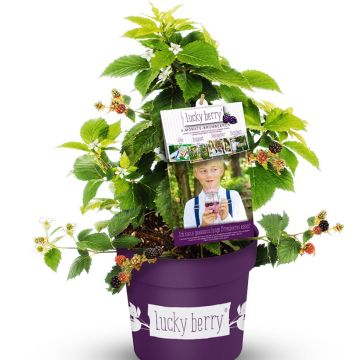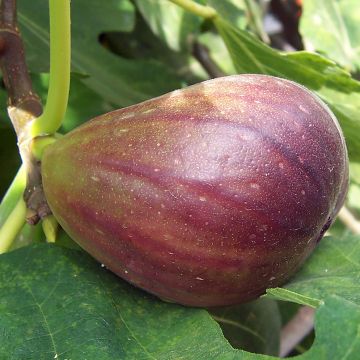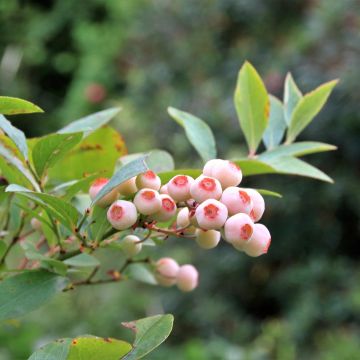

Thornless Evergreen Blackberry - Rubus fruticosus
Thornless Evergreen Blackberry - Rubus fruticosus
Rubus fruticosus Thornless
Blackberry, Bramble
Je confirme, comme un autre commentaire, que ce n'est pas la Thornless evergreen que j'ai recu. Pour en avoir commandé une dans une autre pépiniere, la thornless a en effet des feuilles tres particulieres, celle recu a des feuilles de mure classique (mais pas d'epines). On peut d'ailleurs voir dans les photo sur ce site qu'une photo est bonne (on voit bien les feuilles découpées) alors que l'autre photo n'est pas bonne... J'espere au moins que la ronce recu produira de bons fruits.
Stephane, 12/04/2023
Special offer!
Receive a €20 voucher for any order over €90 (excluding delivery costs, credit notes, and plastic-free options)!
1- Add your favorite plants to your cart.
2- Once you have reached €90, confirm your order (you can even choose the delivery date!).
3- As soon as your order is shipped, you will receive an email containing your voucher code, valid for 3 months (90 days).
Your voucher is unique and can only be used once, for any order with a minimum value of €20, excluding delivery costs.
Can be combined with other current offers, non-divisible and non-refundable.
Home or relay delivery (depending on size and destination)
Schedule delivery date,
and select date in basket
This plant carries a 6 months recovery warranty
More information
We guarantee the quality of our plants for a full growing cycle, and will replace at our expense any plant that fails to recover under normal climatic and planting conditions.
Description
The Thornless evergreen Mulberry is a vigorous, hardy and highly productive variety. Without thorns or almost without, it produces large black-purple, round and slightly elongated fruits. They are tasty, juicy and deliciously acidic. It is a very hardy plant that should be trained along a wall or on a sturdy trellis. It is a self-fertile variety, which yields an abundant harvest in late August and late September. The fruits are delicious fresh and make excellent jams, jellies or pies. Its semi-evergreen finely cut foliage is an additional asset for the garden.
The Mulberry belongs to the genus Rubus, which is native to the mountains of the Caucasus in Asia Minor. The genus has diversified over time and has given rise to several subgenera, including raspberries (Rubus idaeus) and blackberries (Rubus fruticosus). This last genus includes many subspecies that differ in size, colour and acidity level of the fruit. In Europe and America, this berry has been consumed for about 2000 years. The Thornless evergreen Mulberry belongs to the subgenus Rubus fruticosus and is part of cultivated blackberries. It was selected in the USA, in Oregon, Washington.
Hardy and easy to grow, the Thornless evergreen Mulberry thrives in ordinary soil, with a preference for fertile, well-drained and fresh soil. It thrives when grown against a sunny or partially shaded wall, showcasing the bare wood of the flexible branches in winter. Garden Mulberries are hybrids derived from the Thornless Blackberry, Rubus var. inermis, itself obtained by cross-breeding the blackberry and the raspberry. Extensive work has led to the development of many particularly productive thornless varieties, most of which are of American origin.
The Thornless evergreen Mulberry is a climbing perennial plant with a semi-shrubby and bushy habit. The branches reach a length of 2 to 3 m (7 to 10ft), and the stump can occupy 0.5 m (2ft) of ground. These branches should be trained: fence, wire mesh, trellis, pergola, arches... there are numerous solutions.
The foliage is semi-evergreen, bright green, composed of finely cut and toothed leaves, with visible veins, very similar to raspberry leaves. The stems are thornless. If one of them has thorns, cut it flush with the ground. They only live to bear fruit (2 years) and are gradually replaced by suckers coming from the stump.
The abundant and honey-scented flowering shows numerous small white-pink flowers with a diameter of 1.5 to 2 cm (1in), grouped in clusters. It takes place from May to June, from the first year of planting.
The fruits that form are composed of agglutinated drupes on the receptacle, adherent. They are large, much larger than those of wild blackberries, turning red and then black when ripe, from August to October. They should be picked when fully black, as they are then sweet and acidic, juicy and flavorful. The fruits can be consumed fresh as soon as they are picked, in jellies, jams, on pies or even in sorbets, syrups and juices. They can be perfectly preserved in the freezer.
Report an error about the product description
Thornless Evergreen Blackberry - Rubus fruticosus in pictures






Plant habit
Fruit
Flowering
Foliage
Botanical data
Rubus
fruticosus
Thornless
Rosaceae
Blackberry, Bramble
Cultivar or hybrid
Other Blackberry bush
View all →Planting and care
The Thornless evergreen Blackberry bush prefers deep, fertile soils, not too dry but moist, but it is a low-maintenance plant that will adapt to any ordinary soil that is not too dry. This blackberry bush bears fruit in the sun, in partial shade, or even in shade, but the fruits will be of lesser quality. When grown in a pot, it can be planted at any time of the year. However, it is preferable to plant it in the garden in autumn, from September to December.
Dig a hole twice as large as the root system. Loosen the root ball with a lightly sharp tool to untangle the roots and promote growth. Place the bush in the hole without burying it too much. Water well to compact the soil and remove air around the roots. It is important to ensure that the plant does not lack water during the first year after planting. Similarly, during the first year, only keep the vigorous stems. Organic fertilizer is beneficial at the start of the growing season. Train the new stems as they grow to prevent overgrowth: the blackberry bush naturally layers, meaning that if a branch touches the ground for a prolonged period, it will develop roots and new stems, creating a new bush.
Planting period
Intended location
Care
-
, onOrder confirmed
Reply from on Promesse de fleurs
Similar products
Haven't found what you were looking for?
Hardiness is the lowest winter temperature a plant can endure without suffering serious damage or even dying. However, hardiness is affected by location (a sheltered area, such as a patio), protection (winter cover) and soil type (hardiness is improved by well-drained soil).

Photo Sharing Terms & Conditions
In order to encourage gardeners to interact and share their experiences, Promesse de fleurs offers various media enabling content to be uploaded onto its Site - in particular via the ‘Photo sharing’ module.
The User agrees to refrain from:
- Posting any content that is illegal, prejudicial, insulting, racist, inciteful to hatred, revisionist, contrary to public decency, that infringes on privacy or on the privacy rights of third parties, in particular the publicity rights of persons and goods, intellectual property rights, or the right to privacy.
- Submitting content on behalf of a third party;
- Impersonate the identity of a third party and/or publish any personal information about a third party;
In general, the User undertakes to refrain from any unethical behaviour.
All Content (in particular text, comments, files, images, photos, videos, creative works, etc.), which may be subject to property or intellectual property rights, image or other private rights, shall remain the property of the User, subject to the limited rights granted by the terms of the licence granted by Promesse de fleurs as stated below. Users are at liberty to publish or not to publish such Content on the Site, notably via the ‘Photo Sharing’ facility, and accept that this Content shall be made public and freely accessible, notably on the Internet.
Users further acknowledge, undertake to have ,and guarantee that they hold all necessary rights and permissions to publish such material on the Site, in particular with regard to the legislation in force pertaining to any privacy, property, intellectual property, image, or contractual rights, or rights of any other nature. By publishing such Content on the Site, Users acknowledge accepting full liability as publishers of the Content within the meaning of the law, and grant Promesse de fleurs, free of charge, an inclusive, worldwide licence for the said Content for the entire duration of its publication, including all reproduction, representation, up/downloading, displaying, performing, transmission, and storage rights.
Users also grant permission for their name to be linked to the Content and accept that this link may not always be made available.
By engaging in posting material, Users consent to their Content becoming automatically accessible on the Internet, in particular on other sites and/or blogs and/or web pages of the Promesse de fleurs site, including in particular social pages and the Promesse de fleurs catalogue.
Users may secure the removal of entrusted content free of charge by issuing a simple request via our contact form.
The flowering period indicated on our website applies to countries and regions located in USDA zone 8 (France, the United Kingdom, Ireland, the Netherlands, etc.)
It will vary according to where you live:
- In zones 9 to 10 (Italy, Spain, Greece, etc.), flowering will occur about 2 to 4 weeks earlier.
- In zones 6 to 7 (Germany, Poland, Slovenia, and lower mountainous regions), flowering will be delayed by 2 to 3 weeks.
- In zone 5 (Central Europe, Scandinavia), blooming will be delayed by 3 to 5 weeks.
In temperate climates, pruning of spring-flowering shrubs (forsythia, spireas, etc.) should be done just after flowering.
Pruning of summer-flowering shrubs (Indian Lilac, Perovskia, etc.) can be done in winter or spring.
In cold regions as well as with frost-sensitive plants, avoid pruning too early when severe frosts may still occur.
The planting period indicated on our website applies to countries and regions located in USDA zone 8 (France, United Kingdom, Ireland, Netherlands).
It will vary according to where you live:
- In Mediterranean zones (Marseille, Madrid, Milan, etc.), autumn and winter are the best planting periods.
- In continental zones (Strasbourg, Munich, Vienna, etc.), delay planting by 2 to 3 weeks in spring and bring it forward by 2 to 4 weeks in autumn.
- In mountainous regions (the Alps, Pyrenees, Carpathians, etc.), it is best to plant in late spring (May-June) or late summer (August-September).
The harvesting period indicated on our website applies to countries and regions in USDA zone 8 (France, England, Ireland, the Netherlands).
In colder areas (Scandinavia, Poland, Austria...) fruit and vegetable harvests are likely to be delayed by 3-4 weeks.
In warmer areas (Italy, Spain, Greece, etc.), harvesting will probably take place earlier, depending on weather conditions.
The sowing periods indicated on our website apply to countries and regions within USDA Zone 8 (France, UK, Ireland, Netherlands).
In colder areas (Scandinavia, Poland, Austria...), delay any outdoor sowing by 3-4 weeks, or sow under glass.
In warmer climes (Italy, Spain, Greece, etc.), bring outdoor sowing forward by a few weeks.
















































